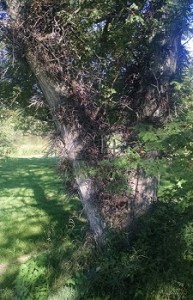
Locust Tree–taken July 2015 on campus of Carl Sandburg College in Galesburg, IL by Michael John Neill
Blog posts with illustrations generate more interest and more traffic. It’s a simple fact. There is only one real problem I have with this:
I hate to include a picture with a post simply for the purpose of “having a picture.”
I also don’t like to waste time looking for “just the right image,” getting permission to use that image (if the creator hasn’t allowed permission or if the item has not been public domain) and then formatting the attribution.
So when I need a “stock image” for an illustration, I’ve taken to creating my own. Sometimes those pictures are of items that I can photograph and other times images have been pictures of highly artistic pictures that I have drawn.
But if I create the image myself, then I do not have to worry about anyone claiming that I used their picture. Similarly to the same way that if I create my own textual content that I don’t have to worry about anyone claiming that I stole that either.
Other than personal drawings and photos of items in my surroundings, I do occasionally publish images of various records on my blog. Normally these images are of records that are publicly available. I don’t publish images of items that are in restricted collections as that may violate any terms of use I have for the material from that location.
The other advantage of creating my own illustrations–no one is probably going to steal them and use them on their own blog. I’m not an artist nor am I a photographer.
This goes back to my prime directive to create my own content. It’s more work, but it cuts down on other sorts of headaches.